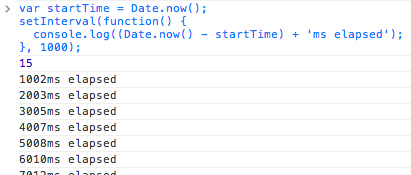Recently, I've been toying with JavaScript's setInterval method which, if you're unfamiliar, allows you to execute code repeatedly at a specified time interval. For example, one might create an interval which executes every second by using the following code snippet:
setInterval(function () {
console.log('I execute every second!');
}, 1000);
Both setInterval and its close cousin setTimeout suffer from latency caused by JavaScript's single-threaded nature. While you may intend for an interval to execute every 1000 milliseconds, in reality it could take slightly longer for the function to be triggered. This is typically only a few milliseconds and therefore might appear to be a negligible problem. You might also expect that subsequent intervals would make an effort to get the code execution back on a predictable schedule. In other words, if there was 1007 milliseconds between registering the interval and the first code execution (a delay of 7 milliseconds), you could expect the next execution to occur as close to 2000 milliseconds as possible (i.e. 993 milliseconds later).
Depending on your browser, however, this may not be the case. We can demonstrate this by tracking the number of milliseconds which have passed since setInterval was registered:
var startTime = Date.now();
setInterval(function () {
console.log(Date.now() - startTime + 'ms elapsed');
}, 1000);
If you run this in current versions of Chrome, Safari, Internet Explorer, or Node.js, you'll notice that the interval execution grows increasingly out of sync with the original setInterval function call.

In my testing, I've found that only Firefox attempts to keep the interval execution in sync.
Regardless of whether this is the intended behavior of setInterval, I needed a means by which I could execute code as closely as possible to a predictable interval. Below is my solution to this problem:
window.setCorrectingInterval = function (func, delay) {
var instance = {};
function tick(func, delay) {
if (!instance.started) {
instance.func = func;
instance.delay = delay;
instance.startTime = new Date().valueOf();
instance.target = delay;
instance.started = true;
setTimeout(tick, delay);
} else {
var elapsed = new Date().valueOf() - instance.startTime,
adjust = instance.target - elapsed;
instance.func();
instance.target += instance.delay;
setTimeout(tick, instance.delay + adjust);
}
}
return tick(func, delay);
};
Including the code sample above will add a new setCorrectingInterval function to the window global that can be called using the same parameters you would normally pass to setInterval. Here's a detailed breakdown of what's going on in the new function:
- To track properties related to this particular interval instance, we wrap the inner
tickfunction inside a closure construct. - When the function is first called (i.e. when
instance.startedisfalse), a number of properties are stored to ourinstanceobject. - In place of
setInterval, we repeatedly callsetTimeout, passing thetickfunction and an adjusted delay. - The adjusted delay is calculated by tracking both the start time of the original function call and an incremented target execution time.
To achieve the desired behavior, we can update the broken example to use setCorrectingInterval in place of setInterval.
var startTime = Date.now();
setCorrectingInterval(function () {
console.log(Date.now() - startTime + 'ms elapsed');
}, 1000);
As can be seen in the image below, the number of milliseconds elapsed does not continuously increase, but instead aims to occur as closely as possible to the intended once-per-second schedule.

If you find this useful, I've created a more full-featured version, which includes a matching clearCorrectingInterval and adds the option to pass arguments (refer to setInterval's method signature for more information). You can read more about it, including download instructions, on the GitHub repository.
